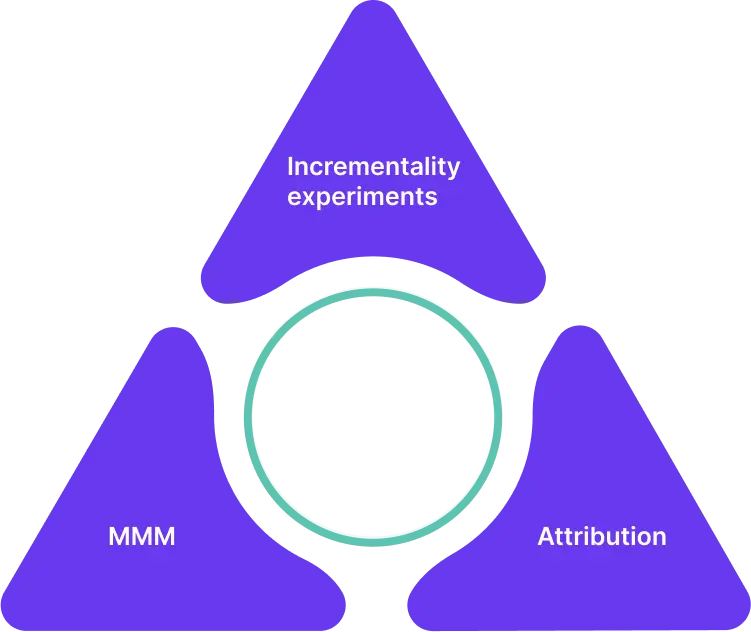As a performance marketer, clearly understanding your return on investment (ROI) is paramount. But what happens when your traditional attribution models start failing you? You see discrepancies between reported and actual results, making it hard to trust the data.
Before you can confidently allocate your marketing budget, you need a reliable way to measure the true impact of your efforts.
This blog will explain the challenges in measuring marketing ROI and explore three advanced methodologies, marketing mix modeling (MMM), incrementality testing, and multi-touch attribution (MTA) to help you measure marketing ROI effectively.
Challenges in Measuring Marketing ROI
Attribution limitations
One of the primary challenges in measuring marketing ROI is accurately attributing sales and conversions to the correct marketing activities. Customers often interact with multiple touchpoints before purchasing, making it difficult to pinpoint which channel or campaign should get the credit.
Data Silos
Data fragmentation across various platforms and tools can create silos, making it challenging to consolidate and analyze data comprehensively. This fragmentation can lead to incomplete or misleading insights, hindering accurate ROI measurement.
Complexity of Customer Journeys
Modern customer journeys are complex and non-linear, involving multiple channels and devices. This complexity complicates the tracking and analysis of customer interactions, making it harder to assess the true impact of each marketing effort.
Inconsistent Reporting
Differences in reporting metrics and standards across various ad platforms can lead to inconsistencies. For instance, the reported conversions on an ad platform may not match the actual orders in your backend system, leading to confusion and inaccurate ROI calculations.
Privacy Regulations
Increasing privacy regulations, such as GDPR and the phasing out of third-party cookies, limit the amount of trackable data. This restriction poses a significant challenge for marketers who rely on detailed user data to measure and optimize their ROI.
Adstock and Saturation Effects
Understanding the adstock (the prolonged effect of an advertising campaign) and saturation (diminishing returns on ad spend) is crucial. Failing to account for these effects can result in overestimating the impact of recent campaigns while underestimating the long-term value of sustained marketing efforts.
Budget Constraints
Comprehensive ROI analysis can be resource-intensive, requiring significant time, technology, and expertise. Smaller marketing teams or those with limited budgets may need more resources to implement robust measurement frameworks.
Marketers can achieve a more accurate and holistic understanding of their marketing ROI by addressing these challenges with sophisticated measurement methodologies like MMM, incrementality testing and MTA.
The Marketing ROI Framework
As the marketing landscape evolves, relying on a single measurement model is insufficient. Many marketing measurement experts like Andrew Covato recommend adopting the triangulated approach to measuring the ROI.

The triangulated approach combines MMM, incrementality testing and MTA to create a robust framework. While each of these measurement methods has its own limitations, integrating them compensates for these weaknesses. This framework adapts to changes in consumer behavior, technology, and privacy regulations, ensuring accurate and reliable ROI measurements.

Here’s a breakdown of this framework in a step-by-step process.
Step 1: Deploy an MMM
Marketing mix modeling is a statistical analysis technique used to measure the impact of various marketing activities on overall sales.
As MMM includes many different channels, from offline to online, like Print, TV, or OOH, it will give you a good understanding of where your budget has a positive impact and is effectively utilized.
How does MMM work?
The statistical approach decomposes revenue into baseline components (such as seasonality and trends), paid components (including all marketing spend), organic components (such as owned media and search trends), and contextual factors (like price changes and promotions).
By attributing portions of revenue to these different components, MMM provides a holistic view of how each marketing channel contributes to the overall ROI. It will also reveal which channels are truly incremental, clarifying where you should invest more.
Step 2: Conduct geo-experiments
Geo-experiments are the most effective way to gather evidence of how much your advertising efforts contribute to your company’s growth. This method provides a scientific evaluation of your entire media performance by leveraging geographic regions to isolate the impact of your marketing activities.
How do geo-experiments work?
Geo-experiments involve selecting a specific geographic region or market where you plan to modify your advertising strategy. This could mean increasing or decreasing your ad spend, targeting a new audience, or even pausing your advertising efforts entirely. You then closely monitor changes in key performance indicators (KPIs) such as sales, sign-ups, or downloads within that area. Analyzing this data allows you to determine the actual impact of your advertising on these outcomes, providing valuable insights into the effectiveness of your marketing strategy.
This approach helps isolate the true effects of marketing efforts, providing a clear picture of their effectiveness and informing more precise budget allocation and strategy adjustments.
Step 3: Adjust MTA insights
Multi-Touch Attribution (MTA) evaluates the effectiveness of marketing efforts at the campaign level by determining the impact of each touchpoint on conversions. This allows marketers to understand which campaign elements drive performance.
While traditional MTA worked well with cookie-level tracking, today’s environment requires a more nuanced approach to maintain campaign insights and accurately measure performance.
Why should you continue using MTA despite its drawbacks?
Multi-touch attribution remains essential despite its limitations. While incrementality tests and MMM have their strengths, they have limitations. Small channels often don’t yield significant results in incrementality tests, and MMM lacks detailed campaign-level insights. MTA addresses these gaps, providing insights into customer journeys and touchpoint impacts.
This integration is crucial for adapting to a future without cookies, ensuring comprehensive performance measurement.
Using MMM results to calibrate attribution outputs
MMM provides valuable insights into the overall effectiveness of different marketing channels. However, MMM results are often aggregated at a high level, making it challenging to apply them directly to specific campaigns or strategies. To bridge this gap, you can calibrate your attribution outputs with MMM results by creating an incrementality factor.
Measurement experts from Google recommend the same in their modern measurement
playbook
How to calculate the incrementality factor?
Let’s understand this better with an example:
Start by pulling an attribution report from your platform. This report provides the Return on Ad Spend (ROAS) for various campaigns.
| Campaign | Attribution ROAS |
| Search Generic – Campaign X | 1.5 |
| Search Generic – Campaign Y | 3 |
| Search Brand – Campaign X | 5 |
| Search Brand – Campaign Y | 4 |
| Display General | 2 |
| Display Customer Match – Campaign X | 8 |
| Display Customer Match – Campaign Y | 1.5 |
Next, calculate the incrementality factor by comparing the ROAS from the same timeframe and level of aggregation between your attribution and MMM reports.
| Campaign | Attribution ROAS | MMM ROAS | Incrementality factor |
| Search Generic | 3 | 2.5 | 0.83 |
| Search Brand | 5 | 4.2 | 0.84 |
| Display General | 2 | 1.8 | 0.90 |
| Display Customer Match | 8 | 8.8 | 1.10 |
Finally, apply the incrementality factor to the initial attribution report to get the estimated ROAS post-reweighting.
| Campaign | Estimated Attribution iROAS |
| Search Generic – Campaign X | 1.5 * 0.83 = 1.25 |
| Search Generic – Campaign Y | 3.0 * 0.83 = 2.49 |
| Search Brand – Campaign X | 5.0 * 0.84 = 4.2 |
| Search Brand – Campaign Y | 4.0 * 0.84 = 3.36 |
| Display General | 2.0 * 0.90 = 1.8 |
| Display Customer Match – Campaign X | 8.0 * 1.10 = 8.8 |
| Display Customer Match – Campaign Y | 1.5 * 1.10 = 1.65 |
By applying these steps, you adjust your attribution results to reflect a more accurate and holistic estimate of your marketing channels’ performance. This approach ensures that your campaign-level insights align with the broader, more aggregated insights provided by MMM, leading to better-informed marketing decisions
Final thoughts
Accurately measuring marketing ROI is crucial for optimizing budget allocation and driving growth. Each methodology of MMM, MTA, and incrementality testing offers unique benefits:
- MMM provides a broad, strategic view across all channels.
- Geo-experiments isolate the true impact of marketing efforts.
- MTA delivers granular insights at the campaign level.
Using a triangulated approach leverages the strengths of each method, offering a comprehensive understanding of marketing performance.
Ready to elevate your marketing ROI measurement? Book a demo with Lifesight today!
Discover More From Lifesight
Essential Resources for Success















